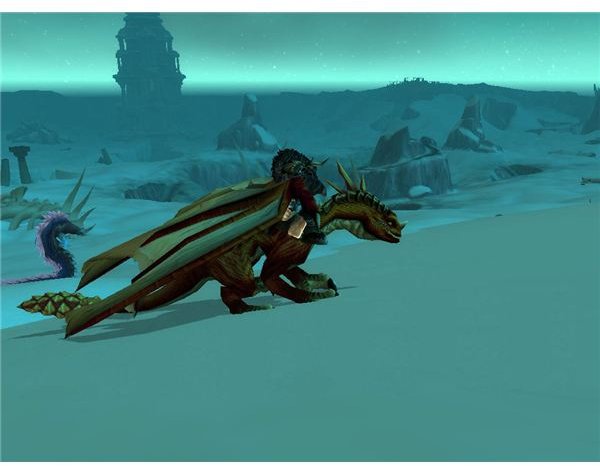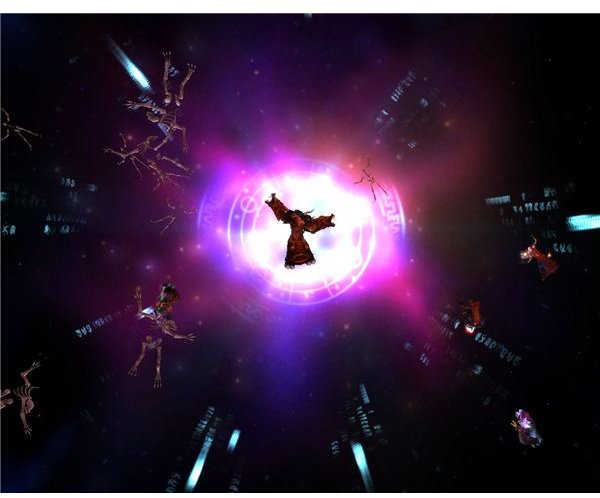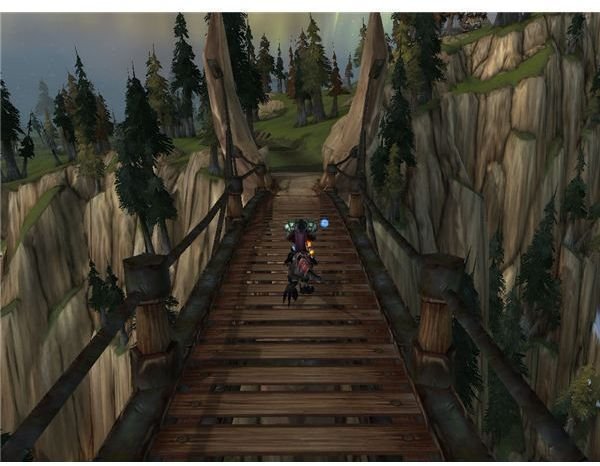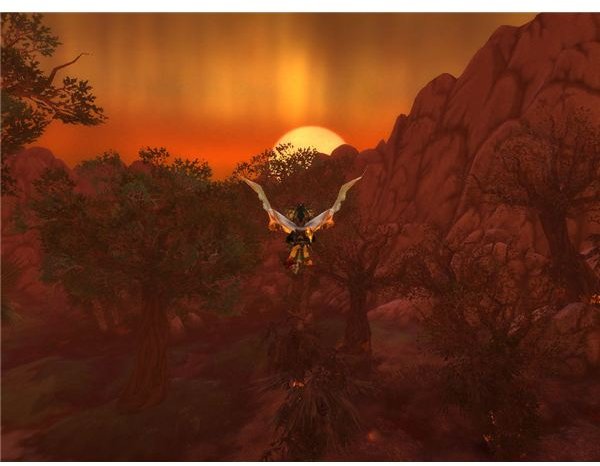Why World of Warcraft Is Brilliantly Designed: For more than five years, WoW has reigned as the MMO market's undisputed pound-for-pound king

Five years after launch: The game is still great
In “Why World of Warcraft is Badly Designed,” Simon Hill hit on some common points of contention with the world’s most popular MMORPG. He opens up with a simple question:
Does WoW’s popularity mean the game is any good?
The answer is a resounding yes.
WoW is the king of polish, flaws and all
Hill wrote at length about what he believes is a poor in-game social experience, the lack of clear objectives, balance problems, and what he feels is a GM staff too heavy-handed with the griefers and ragers found in every online game.
And while I think Hill’s right in some ways – who doesn’t want to see more balance, especially in PvP? – the issues he raises are mostly indicative of MMORPGs as a whole. No matter what one thinks of the genre, the fact remains WoW is the most-appealing, most polished and most celebrated MMORPG to date.

Popularity contest: Are WoW’s legions of players wrong?
Hill’s first argument centers on the issue of popularity. If 11.5 million people play the game, the thinking goes, it must be good. But as Hill notes, there’s no shortage of examples when pointing to entertainment that may be wildly popular but without redeeming qualities. Hill compares World of Warcraft to “the cult of celebrity and the pop charts.”
But WoW isn’t Britney Spears, it isn’t Megan Fox, and it isn’t US Weekly reporting on what Jennifer Aniston had for lunch last Thursday. Gaming itself itself may no longer be a counterculture, but gaming – and MMOs in particular – is still an activity largely restricted to folks sitting at home, on their computers or at their consoles. People don’t pony up $15 a month and $80 for two expansions in addition to the base game because they think they’re getting in on some exclusive club. They do it because they geniunely enjoy the game.
Greener pastures: MMO life isn’t as sweet outside of Azeroth
The argument that WoW is successful because it’s popular, rather than popular because it’s successful, almost makes sense until you check out the wider MMO market and give some of the lesser-known games a go.
Most of them are shockingly unpolished, and if you’re a World of Warcraft player, this is immediately apparent. While we’ve all gotten used to starter areas that make it easy for players to immerse themselves, regular content patches and obsessive balance tweaks, the fact is that’s the exception to the rule.
Ask any player in the ghost town that is The Matrix Online if they wish the mobs didn’t topple over in glitchy animations, or if they’d like new content to explore, and they’d jump at the prospect. Likewise with Age of Conan, which was widely praised for superior graphics and an innovative combat system, but was panned for its overall poor player experience at launch.
Maintaining player loyalty through gameplay excellence
There’s a reason Blizzard’s reportedly spent some $500 million in continued development costs on World of Warcraft since the game’s 2004 launch – the company knows new dungeons, zones, spells and storylines keep players happy and engaged. And it knows players are likely to look elsewhere if they’re left to the mercy of griefers, script-kiddies and others who are poisonous to an online community.
Hill laments the fact that Blizzard is quick to ban griefers and hackers, and points to what he calls “a convoluted rule set” that governs the game. But the fact that Blizzard takes an active role in keeping the playing experience pleasant is a major factor in why it’s been able to retain millions upon millions of players for more than five years. Many a great game has been ruined by publishers who have turned a blind eye to cheating and community-killers in online games – just ask EA, which has a shelf worth of titles that could have had the staying power of Starcraft or Warcraft, but have been abandoned en masse because the company won’t devote developer resources to maintaining its player base.

While those companies shift their resources to the next title – even if it means abandoning the player base of an existing title – Blizzard sees potential loyalty and legacy in cultivating those online communities, and ensuring their longevity with content and fixes. A competitor might release a handful of patches in a year, then move on to the next title. Blizzard conducts maintenance every week, hotfixes bugs and exploits as they appear, and issues massive, game-changing content patches every few months.
The journey is part of the fun: Gameplay over reward
Hill’s next two gripes are indicative of MMOs as a whole, and aren’t limited to WoW – the lack of tangible rewards in the game, and the emphasis on “time over skill.”
To normal, healthy players, the game itself is a reward. It’s a seemingly-endless escape, a fantasy world filled with rich lore and thousands of intertwining backstories, It has heavily stylized and often beautiful locales, and the potential to meet like-minded people you can enjoy the game with.
To normal, healthy players, “phat purplez” or the false prestige that comes with attaining a particular title or mount are not the rewards. Sure, if you worked hard at coordinating 24 other people to down Sartharion and his three drakes in one shot, it’s nice to have a title and a fancy drake to fly around on as your reward. But the actual fun of it is the gameplay itself – those moments when you realize a boss who’s been a guild roadblock is going to finally keel over and die, or when you forget how much damage you’re putting out and find yourself joyfully slaying opponents in a battleground. Where gear, gold and prestige items might be carrots offered to heavily-invested hardcore players, Blizzard has done an amazing job at removing the tedium of a typical MMORPG end-game.

The myth of “skill” in appeasing casuals and hardcores
And though skill probably isn’t the right word – in describing any video game – challenges present themselves to player who look for them. The numbers speak for themselves – only tiny fractions of the playerbase have hit a 2k rating in ranked arena, or have downed bosses like Kil’Jaeden or Kel’Thuzad in their end-game prime. It was months before players figured out how to handle the Sartharion Twilight Zone achievement, and many months after patch 3.2 delivered Ulduar, bosses like Yogg-Saron still present a challenge to many guilds.
Where WoW succeeds in this design element is in recognizing the need for hard-mode encounters to satiate the hardcore, while realizing more casual players want to visit those same dungeons and fight the same bosses on a lower difficulty. In The Burning Crusade, the developers tried to compromise with adjusting difficulty level via raid tier. In Wrath of the Lich King, they’ve taken things a step further, making end-game dungeons more accessible to casuals, but still daunting to the hardcore element that wants a challenge.
Balance: The plague of all MMOs
Lastly, Hill points out the lack of balance among World of Warcraft’s classes, and even the game’s biggest fanboys would be hard-pressed to argue the point. This is one area an eventual WoW-killer will get right.
Do players realize the enormity of balancing ten classes to near-equal effectiveness, not only in PvE, but in PvP as well? We’re talking about millions of lines of code, thousands of animations, and endless permutations in terms of how new abilities counteract with existing ones. This is enormously difficult stuff. Yet who can blame the players for getting angry when Blizzard’s development staff begs off with an excuse about how it’s just too difficult to balance everything? This is the world’s greatest MMO company, and the world’s greatest MMO – they should be able to get such a fundamental thing as balance right, don’t you think?

WoW is still king
But yet again, WoW is measured against its competitors, and none of them match up. In the end, it comes back to popularity – players aren’t going to leave in droves for a less well-polished game because of balance issues, especially when those balance issues exist in every MMO.
Ultimately, it comes down to the fact that no other publisher has managed to do what Blizzard has done. Until an MMO that delivers all the goods comes along, WoW is still the reigning king.
This post is part of the series: WoW Reviews
Take a look at this article series for a collection of viewpoints on World of Warcraft and other competing MMORPG’s.
